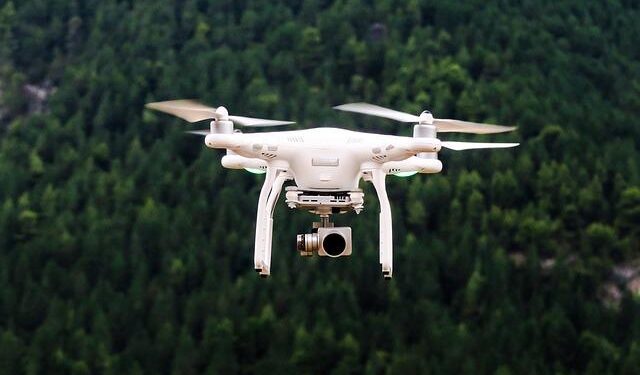Estonia is set to advance its aerial defense capabilities with the deployment of an innovative “drone wall,” aiming to counter the growing threats posed by unmanned aerial vehicles. As drones become increasingly prevalent in both civilian and military spheres, Tallinn’s initiative represents a proactive step in safeguarding national airspace. However, questions remain whether this technology alone can address the complexities of modern security challenges. This article explores Estonia’s new defense measure and evaluates its effectiveness amid evolving tactical realities.
Estonia’s Drone Wall Initiative and Its Strategic Importance for National Security
Estonia’s bold step to deploy a technologically advanced “drone wall” signals a strategic pivot in its national defense posture. Designed to detect, track, and neutralize unauthorized UAVs along its borders, this system leverages cutting-edge radar, AI-powered analytics, and electronic countermeasures. By integrating real-time threat assessment with rapid-response protocols, Estonia aims to bolster its defense against the increasingly sophisticated and varied drone threats that modern conflicts present. This initiative not only enhances Estonia’s situational awareness but also acts as a force multiplier in protecting critical infrastructure and urban centers from aerial surveillance and potential attacks.
However, the efficacy of the drone wall must be weighed against evolving challenges in drone warfare. The system’s success depends on neutralizing threats such as:
- Swarm Attacks: Mass drone encounters designed to overwhelm defenses
- Stealth Drones: Low-signature UAVs designed to evade radar detection
- Electronic Warfare: Jamming and spoofing attempts targeting drone control systems
Considering these dynamic threats, Estonia’s drone wall represents a critical component-but not a standalone solution-in a layered security strategy. Integration with manned air defense units, cyber defense measures, and intelligence sharing within NATO frameworks will determine its overall strategic impact in safeguarding national sovereignty.
| Feature | Capability | Importance Level |
|---|---|---|
| Radar Detection | Long-range UAV tracking | High |
| AI Analytics | Threat classification & prioritization | High |
| Electronic Countermeasures | Drone signal disruption | Medium |
Evaluating the Effectiveness of Drone Defense Amid Evolving Aerial Threats
As drone technology advances at a rapid pace, traditional defense systems face increasing challenges in effectively neutralizing swarms of aerial threats. Estonia’s proposed “Drone Wall” aims to integrate radar detection, radio frequency jamming, and kinetic interceptors into a cohesive shield; however, questions remain about its adaptability against agile, low-signature drones equipped with autonomous navigation and counter-countermeasures. The evolving tactics of hostile UAVs, from coordinated swarm behaviors to electronic warfare capabilities, demand that any defensive system not only reacts quickly but also anticipates next-generation threats with flexible, layered responses.
- Detection: Enhanced radar and signal intelligence systems capable of low-visibility threat identification
- Interception: Rapid deployment interceptors and directed energy weapons for immediate neutralization
- Countermeasures: Adaptive jamming techniques to disrupt drone communication and control
- Integration: Real-time data fusion for a comprehensive situational awareness and command response
| Threat Type | Defense Challenge | Potential Solution |
|---|---|---|
| Swarm Attack | Overwhelms interception capacity | AI-driven resource allocation |
| Low-altitude Stealth Drones | Radar detection limitations | Multispectral sensor arrays |
| Autonomous Navigation | Unpredictable flight paths | Advanced predictive algorithms |
| Electronic Countermeasures | Jamming resistance | Dynamic frequency hopping |
Expert Recommendations for Enhancing Estonia’s Integrated Airspace Protection System
Leading defense analysts emphasize that while Estonia’s deployment of a “drone wall” represents a significant stride in counter-drone technology, relying solely on static physical barriers could prove insufficient against evolving aerial threats. Experts advocate for a layered defense strategy that integrates advanced radar systems, real-time data fusion from multiple sensors, and AI-driven threat identification algorithms to actively track and neutralize hostile UAVs before they pose a risk. Additionally, collaboration with NATO partners to exchange intelligence and deploy interoperable systems would enhance national and regional airspace security.
Recommendations further stress the importance of robust cyber defenses to safeguard control networks from electronic warfare and hacking attempts that could undermine the entire integrated shield. A dynamic response capability, including mobile interception units and electronic jamming technologies, must complement fixed installations to adapt swiftly to unpredictable threat vectors. Experts outline the following critical components for a resilient integrated system:
- Multi-sensor integration: Combining radar, acoustic, and EO/IR sensors to improve drone detection accuracy
- AI-enabled automation: For rapid threat classification and decision-making under human supervision
- Interoperability: Seamless communications between civilian air traffic control, military assets, and allied forces
- Electronic countermeasures: Deploying adaptive jamming and spoofing to disrupt hostile drone navigation
- Continuous training & upgrades: Regular drills and technological refreshes to stay ahead of emerging threats
| Component | Purpose | Benefit | ||||||||||||||||
|---|---|---|---|---|---|---|---|---|---|---|---|---|---|---|---|---|---|---|
| Multi-sensor Fusion | Enhanced detection scope | recommendations: “`html
|
















